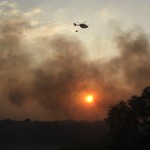High Wildfire Risk, Longer Fire Season Possible This Year

Photo by REUTERS/JOSHUA LOTT/LANDOV
Scientists warn that wildfire risks could be increasing in the Southwest due to climate change.
Major wildfires could occur across the Southwest this year, including in Texas, according to several scientists on a Climate Nexus panel Tuesday. Now that Texas in its third year of drought, the state is likely to experience a longer fire season as a result of dry conditions and rising summer temperatures. High fire risk conditions raise the concern that Texas could again experience severe wildfires. Fires on Labor Day weekend in 2011 destroyed more than 1,600 Texas homes. And this week, wildfires raged in California and New Mexico, charring the landscape and forcing 2,000 residents to evacuate an area north of Los Angeles.
According to Dr. Valerie Trouet, an Assistant Professor of Dendrochronology (the study of tree rings) at the University of Arizona, wildfires in the American Southwest during the previous century were much less frequent and severe than fires have typically been throughout the region’s history. However, that reality may not hold for this century.
“The 20th century has been extraordinary relative to previous centuries in terms of fire suppression,” Trouet said. “Our experience in the 20th century is not the natural state of fire frequency throughout the Southwest, and the West in general.”
In recent decades, the frequency of large wildfires and the length of the fire season have increased substantially, according to a draft report by the federal National Climate Assessment and Development Advisory Council (NCADAC). Earlier spring snowmelts and warmer spring and summer temperatures have increased the risk of fire in the Southwest. Fire models predict that more wildfires will occur in the future, with increased risks to communities throughout the region.
If climate conditions become permanently hotter and drier in the Southwest, the region may experience more wildfires during this century than in the past one, but Trouet cautions that there is a great deal of uncertainty about how climate change will affect specific areas.
“Although the globe as a whole is warming, some areas are now projected to have colder winters,” Trouet said. Melting polar ice caps in the Arctic, she explained, have influenced the temperature of the jet stream, which now carries colder-than-average weather to the middle latitudes.
“There is a clear, intuitively sound relationship between climate and fire,” said Dr. Jennifer Marlon, an associate research scientist at Yale School of Forestry and Environmental Studies. “We see very little wildfire activity in the West when the climate was colder and wetter… When you get higher temperatures, you get more fire.”
Dr. Max Moritz, head of the Moritz Fire Lab at the University of California at Berkeley, said that homeowners in fire-prone regions can take steps to reduce their vulnerability. Clearing brush or removing debris from gutters and attics, for instance, can reduce the likelihood that homes will be destroyed in the event of a wildfire. But in the long term, Morris says development may have to change in regions that are at risk of fire.
“It’s really an issue of where and how we’re developing our communities, and thinking about fire in a light that’s more similar to other natural hazards, like floods or earthquakes,” Moritz said. “Historically, we haven’t thought about fire in that light … It’s a combined problem with how and where we live, and how we’re going to have to coexist with fire as we go forward.”
